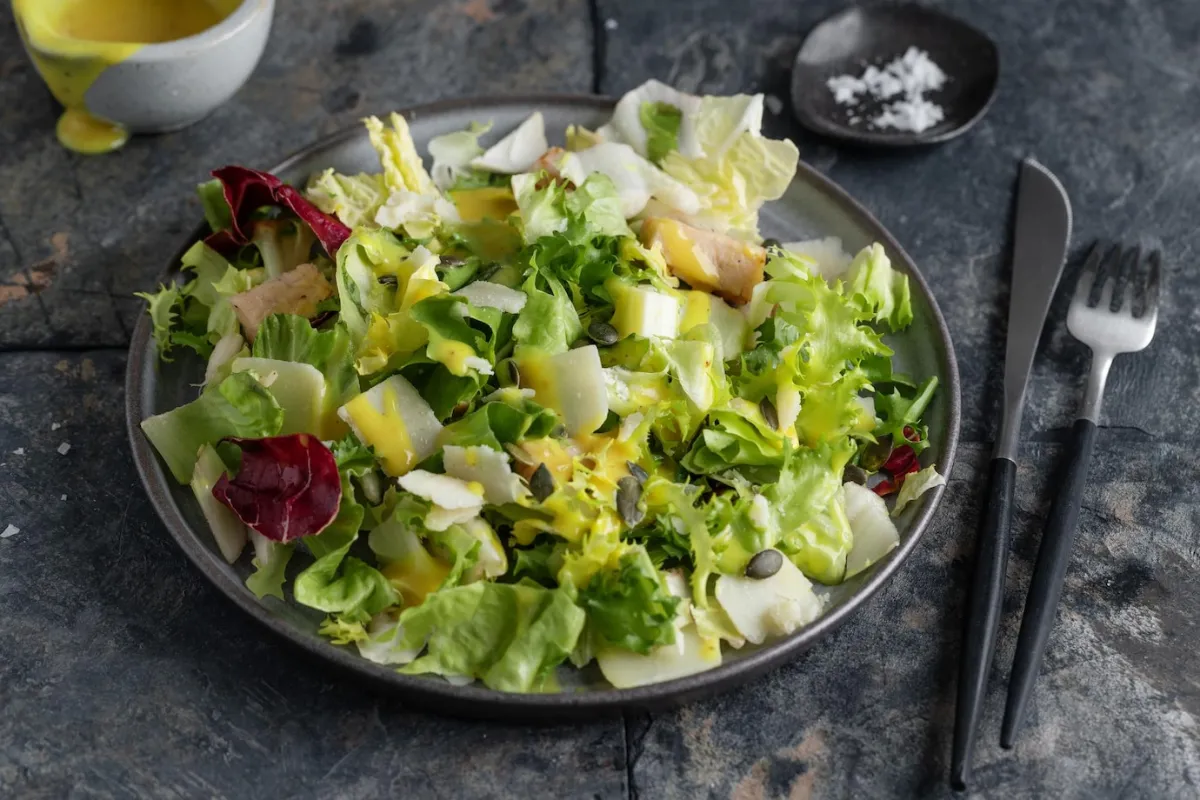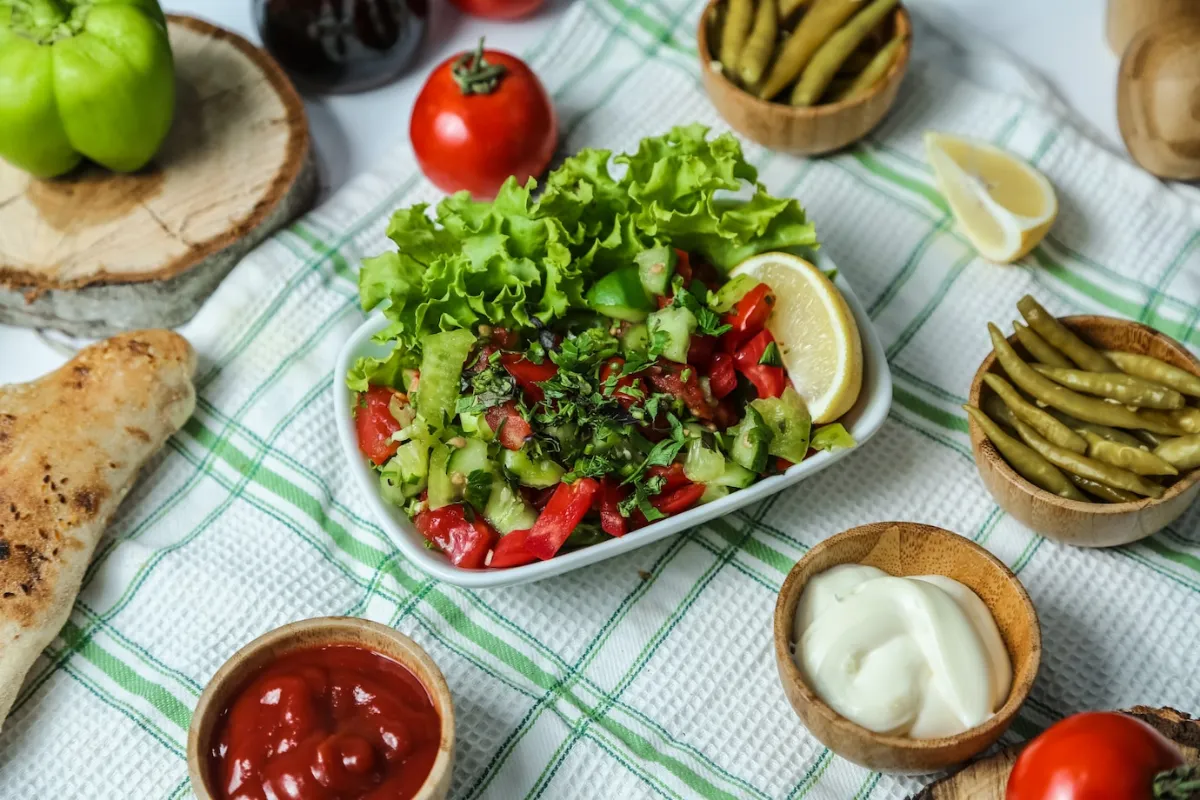Introduction
Caesar salad is a classic dish loved for its rich flavors and satisfying texture. Central to this beloved salad is the Caesar salad sauce, a dressing that brings together all the ingredients in perfect harmony. But what exactly is Caesar salad sauce made of? In this article, we will explore the traditional ingredients that make up this iconic dressing, variations you can try, and tips for making the perfect Caesar salad sauce at home.
We’ll also dive into the history of Caesar salad, providing context for how this dressing became so popular. Whether you’re a seasoned chef or a home cook, understanding what goes into Caesar salad sauce will help you appreciate this dish even more.
A Brief History of Caesar Salad
Before we get into the ingredients, it’s worth understanding where Caesar salad comes from. Contrary to popular belief, Caesar salad was not named after Julius Caesar. It was actually invented by Caesar Cardini, an Italian-American restaurateur, in the 1920s. The story goes that Cardini created the salad on a busy Fourth of July weekend when his kitchen was running low on supplies. He used what he had on hand—romaine lettuce, croutons, Parmesan cheese, and a simple yet flavorful dressing that would later become the Caesar salad sauce.
The dressing was originally made tableside, with Cardini or his staff mixing the ingredients in front of the guests. This added a level of showmanship to the dish, which helped it gain popularity. Over time, the Caesar salad sauce became the star of the dish, with many variations emerging as chefs and home cooks experimented with the recipe.
Traditional Ingredients of Caesar Salad Sauce
The traditional Caesar salad sauce is a rich and creamy dressing made from a few simple ingredients. Here’s what goes into the classic recipe:
- Olive Oil: The base of the dressing, olive oil adds richness and depth to the sauce. It’s important to use high-quality extra virgin olive oil for the best flavor.
- Egg Yolks: Egg yolks give the dressing its creamy texture. They are also responsible for the emulsion that holds the dressing together.
- Garlic: Fresh garlic is essential for that signature Caesar salad bite. It adds a pungent, savory flavor that complements the richness of the other ingredients.
- Anchovies: Anchovies are a key ingredient in traditional Caesar salad sauce. They add a salty, umami flavor that’s hard to replicate with other ingredients. If you’re making the sauce from scratch, you’ll typically mash the anchovies into a paste before mixing them into the dressing.
- Lemon Juice: Lemon juice adds acidity, which balances the richness of the egg yolks and olive oil. It also brightens the flavor of the dressing.
- Worcestershire Sauce: Worcestershire sauce is a complex condiment that adds a touch of sweetness and umami to the dressing. It’s often included in the traditional recipe to enhance the depth of flavor.
- Dijon Mustard: Dijon mustard helps stabilize the emulsion and adds a subtle tanginess to the dressing.
- Parmesan Cheese: Finely grated Parmesan cheese is often mixed into the dressing, adding a nutty, salty flavor that’s characteristic of Caesar salad.
- Salt and Pepper: Seasoning is crucial to bring all the flavors together. Freshly ground black pepper is typically used to add a bit of spice, while salt enhances all the other flavors.
Variations of Caesar Salad Sauce
While the traditional recipe is a classic, there are many variations of Caesar salad sauce that cater to different tastes and dietary needs. Here are a few popular ones:
1. Egg-Free Caesar Salad Sauce
For those who are concerned about consuming raw eggs, there are egg-free versions of Caesar salad sauce. These often use mayonnaise as a base, which provides the creamy texture without the need for raw eggs.
Ingredients:
- Mayonnaise
- Olive oil
- Garlic
- Anchovies or anchovy paste
- Lemon juice
- Dijon mustard
- Worcestershire sauce
- Grated Parmesan cheese
- Salt and pepper

2. Vegan Caesar Salad Sauce
Vegan versions of Caesar salad sauce replace the egg yolks and Parmesan with plant-based alternatives. Nutritional yeast is often used to replicate the cheesy flavor of Parmesan, and silken tofu or cashew cream can be used to create a creamy texture.
Ingredients:
- Olive oil or vegan mayonnaise
- Nutritional yeast
- Garlic
- Capers (as a substitute for anchovies)
- Lemon juice
- Dijon mustard
- Worcestershire sauce (vegan version)
- Salt and pepper
3. Greek Yogurt Caesar Salad Sauce
For a lighter version of Caesar salad sauce, Greek yogurt can be used as the base. This version is lower in fat and calories but still provides a rich and creamy texture.
Ingredients:
- Greek yogurt
- Olive oil
- Garlic
- Anchovies or anchovy paste
- Lemon juice
- Dijon mustard
- Worcestershire sauce
- Grated Parmesan cheese
- Salt and pepper
Step-by-Step Instructions for Making Caesar Salad Sauce
Making Caesar salad sauce at home is simple and rewarding. Here’s how you can do it:
1. Prepare the Ingredients
Before you start, make sure you have all your ingredients ready. If you’re using anchovies, mash them into a paste using a mortar and pestle or the back of a spoon.
2. Create the Emulsion
In a large bowl, whisk together the egg yolks, Dijon mustard, and mashed anchovies. Slowly drizzle in the olive oil while whisking continuously to create an emulsion. The mixture should thicken as the oil is incorporated.
3. Add the Remaining Ingredients
Once the emulsion is stable, add the garlic, lemon juice, Worcestershire sauce, and Parmesan cheese. Whisk until the ingredients are fully combined.
4. Season to Taste
Taste the dressing and season with salt and pepper as needed. If the dressing is too thick, you can thin it out with a little water or more lemon juice.
5. Store or Serve
The Caesar salad sauce can be used immediately or stored in an airtight container in the refrigerator for up to 3 days. If storing, give it a good whisk before using, as the ingredients may separate over time.
Tips for the Perfect Caesar Salad Sauce
Here are some tips to ensure your Caesar salad sauce turns out perfectly every time:
- Use Fresh Ingredients: The quality of your ingredients will greatly affect the flavor of the sauce. Use fresh garlic, high-quality olive oil, and freshly grated Parmesan for the best results.
- Control the Garlic: The amount of garlic you use can be adjusted based on your taste. If you prefer a milder flavor, use less garlic or roast it before adding it to the sauce.
- Balance the Flavors: The key to a great Caesar salad sauce is balancing the rich, savory, and tangy flavors. Taste the sauce as you go and adjust the ingredients to suit your palate.
Nutritional Information
Caesar salad sauce, while rich and flavorful, is also calorie-dense due to the use of olive oil, egg yolks, and Parmesan cheese. Here’s a general breakdown of the nutritional content per serving (based on a traditional recipe):
- Calories: 200-250
- Fat: 20-25g
- Protein: 2-4g
- Carbohydrates: 1-2g
- Fiber: 0g
To reduce the calorie content, you can use a lighter version, such as the Greek yogurt-based sauce, which lowers the fat content while still providing creaminess.
Customizing Caesar Salad Sauce for Dietary Needs
Caesar salad sauce can be easily adapted to meet various dietary preferences:
1. Gluten-Free
Most Caesar salad sauces are naturally gluten-free, but it’s important to check the labels on Worcestershire sauce, as some brands may contain gluten. Use a gluten-free Worcestershire sauce if necessary.
2. Dairy-Free
For a dairy-free version, omit the Parmesan cheese and use nutritional yeast as a substitute. This will still give you a cheesy flavor without the dairy.
3. Vegan
As mentioned earlier, vegan Caesar salad sauce can be made by substituting egg yolks with vegan mayonnaise or silken tofu, and using nutritional yeast instead of Parmesan cheese.
4. Low-Fat
To reduce the fat content, use Greek yogurt or light mayonnaise as the base instead of olive oil and egg yolks. This will give you a lighter dressing without sacrificing too much flavor.
FAQs
Can I make Caesar salad sauce without anchovies?
Yes, if you prefer to avoid anchovies, you can substitute them with capers or simply omit them. However, anchovies are a key ingredient in traditional Caesar salad sauce and contribute to its unique umami flavor.
How long can I store homemade Caesar salad sauce?
Homemade Caesar salad sauce can be stored in an airtight container in the refrigerator for up to 3 days. Be sure to whisk it again before using if it has separated.
What can I use instead of raw eggs in Caesar salad sauce?
If you’re concerned about using raw eggs, you can use pasteurized eggs or substitute with mayonnaise, which contains egg yolks but is safer to consume.
Can I make Caesar salad sauce vegan?
Yes, you can make a vegan version by using plant-based substitutes for the egg yolks and Parmesan cheese, such as vegan mayonnaise and nutritional yeast.
What’s the best oil to use ?
Extra virgin olive oil is the best choice for Caesar salad sauce due to its rich flavor and health benefits. However, you can also use a neutral oil like canola or grapeseed oil if you prefer a milder flavor.
Conclusion
Caesar salad sauce is a simple yet flavorful dressing that plays a crucial role in the beloved Caesar salad. By understanding the traditional ingredients and exploring various adaptations, you can create a Caesar salad sauce that suits your taste and dietary needs. Whether you stick to the classic recipe or try one of the many variations, this sauce is sure to elevate your salads and impress your guests.
With the tips and information provided in this article, you’re now equipped to make the perfect Caesar salad sauce at home. Enjoy experimenting with different ingredients and techniques, and most importantly, enjoy the delicious results!

